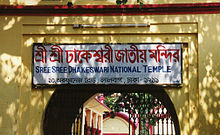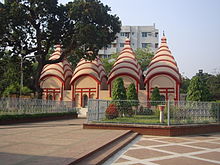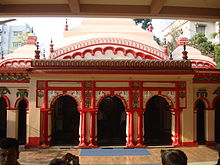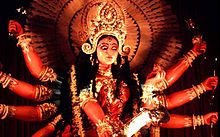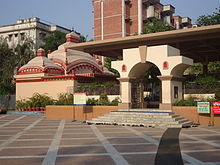- Dhakeswari Temple
-
'Dhakeswari Temple (Bengali: ঢাকেশ্বরী মন্দির ) is an historically significant architectural monument situated at old Dhaka, Bangladesh. It is the National Temple of Bangladesh and the oldest one.
Contents
History
Dhakeshwari is the oldest temple in Dhaka. It is assumed by many that the name of Dhaka is originated from the name of Dhakeswari. It is widely believed that the Queen, wife of King Bijoy Sen went to Langolbond to take a bath. While coming back she gave birth to a son who is known as Ballal Sen in the history. Ballal Sen, after ascending to the throne, has built this temple to glorify his birthplace.
In other hearsay describes that Ballal Sen once dreamt of the deity covered under the jungle. Ballal Sen uncovered the deity from there and built a temple which known by named Dhakeswari. Whatever the hearsay describes Hindu religious think that Dhakeswari is the presiding deity of Dhaka.
Location
The temple is located in old Dhaka right behind the campus of Bangladesh University of Engineering and Technology (BUET), on Orphanage Road near Bakshi Bazar area. There is a permanent alter outside the main temple premises. It hosts the yearly Puja (worship) of Goddess Durga.
Structure
Within the premises of the Dhakeswari there are temples of two types of architecture. The ancient one is of the Poncharotna Goddess Durga’s which lost its actual look after the renovation work. Bradly Bird wrote this at the beginning of this century. The present temple is two hundred years old which was built by an agent of East India Company. Most probably he had renovated the temple. Other than this there are four Shib Temples. According to hearsay in sixteen century king Mansing had built these temples by laying four Shib Lingas there. But this information seems to be unreliable. The fusion of Bangla chowchala and shikor temple is notice in the architecture of Dhakeshawri. Ratan Lal Chakraborti in an article mentioned that “ the structure and architecture of it is like a Boddist Pagoda”. He opined that it was probably a Boddist pagoda which was turned into a Hindu temple later. From this he assumed that the temple was probably built in tenth century.
How did Dhakeshari temple look like in nineteenth century? Ridoynath Majumder described about the temple. At that time the temple was covered by jungle and in its north the Urdu road went westward towards Pilkhana and at its south west was Mirpur road. At its south there was a wood and Urdu bazar was at the east.
Interior view
The temple was panchoratno, at its front Natamandir and around it there is a row of rooms and a big pond and nahobottola gate through which elephant used to go. At its east there are tombs of some saints who used to pray or meditate at the temple. Outside the temple there are 5-6 pagoda with a shiblinga. The priest of Dhakeshawri temple used pray every day. The deity is doshvuja. It is believed that it is made of gold. At the left and right side of the deity there are some other murti. Like the ancient temples its inside is dark. To see the deity light is to be arranged. The temple is owned by many because it is bought by the new caretaker from the old caretakers. Jotindramohan bought it in 1901. Dhakeshawri is crowded but it is an abode of peace. The low sound of the tongue mixes with the evening light and tune of temple bell and make the peaceful environment a happy event.
Religious activities
Najir Hossain recall the memory of Dhakeswari Temple at the 2nd and 3rd decade of this country. It is bit of long but we write down the speech here, then the picture of Dhakeswari will be cleared to you:
At the old time festivals happened on the month of Chaitra in temple complex of Dhakeswari. This place was crowded by various colored shops. Peoples-virtuous comes to visit the temple to gather religious merit and get back to their home. Millions of Hindu religious peoples taking bath at Langolbondon the month of choitra on sukla ostomi time to rid of their sins. People comes to dhakeswari temple by on foot from different roads to be blessed by the deity Durga like a row of ants. It was the best moment of their whole year. With great hope they come out from their home and it’s reflected on their faces, to getting rid of their sins they worship to the Deity with exclusive devotion by bowing their head to mediation of Bhagaban. They forget about everything hunger, sleep, restless everything, they just believe that they will be blessed and they step up for the temple. All those peoples divided into small groups, each groups has ten to twenty. Every one of those group members are women, only one man is there to taking care of them who is the elders of the village. They have comes from very long distance by forming groups. Old peoples, skinny peoples and the oldest are also gathered to this group. Young people from the nearest city to the temple volunteering for the people come from long distance to be blessed by the Deity. With a great concentration, eagerness to the worship of the Deity and often bowing by shouting “Oom Dhaka eswari”.
In present days, each year, the largest celebration of Durga puja(the most important event in the Bengali Hindu calendar) in Dhaka is held at the National Temple, and a stream of dignitaries come to felicitate the Bangladeshi Hindu community from the temple premises. Several thousand worshippers and onlookers (including Muslims) stream through the premises where they are offered prasad(food - usually rice and lentils). A Bijaya Sammelani (cultural program following Durga Puja) takes place in the adjoining parade ground a few days after Durga Puja is complete, and is also a major cultural event in the Dhaka calendar.
One of the most important events of the year is the Janmashtami procession which starts from Dhakeshwari temple and then proceeds through the streets of Old Dhaka; this occurs on the day of the Lord Krishna's birthday, which is also a national holiday in Bangladesh and second only to Durga Puja in importance in the Bengali Hindu calendar.
Present condition
These are not seen any more at Dhakeswari. It was severely damaged during the 1971 Bangladesh Liberation War, and over half of the temple's buildings were destroyed. The main worship hall was taken over by the Pakistan Army and used as an ammunitions storage area. Several of the temple custodians were tortured and killed by the Army though most, including the Head Priest, fled to their ancestral villages and to India and therefore escaped death. After that everything was destroyed of Dhakeswari temple at the time of riot on rule of Ershad president of Bangladesh at 1990 except the outer slough.
National Temple of Bangladesh
In 1996, Dhakeshwari Temple was renamed Dhakeshwari Jatiya Mandir (National Temple) reflecting its position as the center of Hindu culture and worship in Bangladesh. This was the culmination of a major campaign by Bangladeshi Hindu groups who had been demanding official recognition for the primary Hindu place of worship following the declaration of Islam as the state religion in 1988. As a result, the Flag of Bangladesh is hoisted every morning outside the main temple premises, and it follows the National Flag Code rules such as rendering half-mast on nationally declared days of mourning.
References
Book: Dhaka Shriti Bisshiritir Nogori, Author: Muntasir Mamun, Published by Bangla Academy,Bangladesh; ISBN 984 07 3142 4
Categories:
Wikimedia Foundation. 2010.

